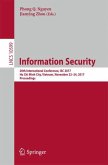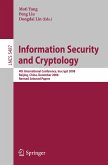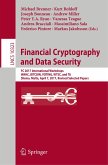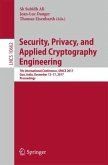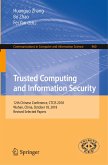Information Security
28th International Conference, ISC 2025, Seoul, South Korea, October 20-22, 2025, Proceedings
Herausgegeben:Cha, Sang Kil; Park, Jeongeun
Information Security
28th International Conference, ISC 2025, Seoul, South Korea, October 20-22, 2025, Proceedings
Herausgegeben:Cha, Sang Kil; Park, Jeongeun
- Broschiertes Buch
- Merkliste
- Auf die Merkliste
- Bewerten Bewerten
- Teilen
- Produkt teilen
- Produkterinnerung
- Produkterinnerung
The book constitutes the proceedings of the 28th International Conference on Information Security, ISC 2025, held in Seoul, South Korea, during October 20 22, 2025.
The 32 full papers presented in these proceedings were carefully reviewed and selected from 77 submissions. The papers are organized in the following topical sections: Cryptanalysis and Cipher Security; Network Security; Post-quantum Cryptography; Side-Channel Attacks and Countermeasures; AI Security; Biometric Security; Malware Analysis; Systems Security; Access Control & Privacy; Smart Contracts and Blockchain Security.
Andere Kunden interessierten sich auch für
![Security Protocols XXIV Security Protocols XXIV]() Security Protocols XXIV38,99 €
Security Protocols XXIV38,99 €![Information Security Information Security]() Information Security38,99 €
Information Security38,99 €![Information Security and Cryptology Information Security and Cryptology]() Moti Yung / Peng Liu / Dongdai Lin (Volume editor)Information Security and Cryptology38,99 €
Moti Yung / Peng Liu / Dongdai Lin (Volume editor)Information Security and Cryptology38,99 €![Financial Cryptography and Data Security Financial Cryptography and Data Security]() Financial Cryptography and Data Security38,99 €
Financial Cryptography and Data Security38,99 €![Security, Privacy, and Applied Cryptography Engineering Security, Privacy, and Applied Cryptography Engineering]() Security, Privacy, and Applied Cryptography Engineering38,99 €
Security, Privacy, and Applied Cryptography Engineering38,99 €![Trusted Computing and Information Security Trusted Computing and Information Security]() Trusted Computing and Information Security39,99 €
Trusted Computing and Information Security39,99 €![Trusted Computing and Information Security Trusted Computing and Information Security]() Trusted Computing and Information Security38,99 €
Trusted Computing and Information Security38,99 €-
-
-
The book constitutes the proceedings of the 28th International Conference on Information Security, ISC 2025, held in Seoul, South Korea, during October 20 22, 2025.
The 32 full papers presented in these proceedings were carefully reviewed and selected from 77 submissions. The papers are organized in the following topical sections: Cryptanalysis and Cipher Security; Network Security; Post-quantum Cryptography; Side-Channel Attacks and Countermeasures; AI Security; Biometric Security; Malware Analysis; Systems Security; Access Control & Privacy; Smart Contracts and Blockchain Security.
The 32 full papers presented in these proceedings were carefully reviewed and selected from 77 submissions. The papers are organized in the following topical sections: Cryptanalysis and Cipher Security; Network Security; Post-quantum Cryptography; Side-Channel Attacks and Countermeasures; AI Security; Biometric Security; Malware Analysis; Systems Security; Access Control & Privacy; Smart Contracts and Blockchain Security.
Produktdetails
- Produktdetails
- Lecture Notes in Computer Science 16186
- Verlag: Springer / Springer Nature Switzerland / Springer, Berlin
- Artikelnr. des Verlages: 89555247, 978-3-032-08123-0
- Seitenzahl: 604
- Erscheinungstermin: 1. Dezember 2025
- Englisch
- Abmessung: 235mm x 155mm
- ISBN-13: 9783032081230
- ISBN-10: 3032081238
- Artikelnr.: 75373071
- Herstellerkennzeichnung
- Springer-Verlag GmbH
- Tiergartenstr. 17
- 69121 Heidelberg
- ProductSafety@springernature.com
- Lecture Notes in Computer Science 16186
- Verlag: Springer / Springer Nature Switzerland / Springer, Berlin
- Artikelnr. des Verlages: 89555247, 978-3-032-08123-0
- Seitenzahl: 604
- Erscheinungstermin: 1. Dezember 2025
- Englisch
- Abmessung: 235mm x 155mm
- ISBN-13: 9783032081230
- ISBN-10: 3032081238
- Artikelnr.: 75373071
- Herstellerkennzeichnung
- Springer-Verlag GmbH
- Tiergartenstr. 17
- 69121 Heidelberg
- ProductSafety@springernature.com
.-Cryptanalysis and Cipher Security.-Improving the Differential-Linear Attack with Applications to GIFT-COFB, GIFT-64 and HyENA.-Keyless Physical-Layer Cryptography.-The Multi-User Security of GCM-SST and Further Enhancements.-Network Security.- SimSeq: A Robust TLS Traffic Classification Method.-EvoFuzz: Enhancing State Space Exploration and Seed Prioritization in Stateful Protocol Fuzzing using Evolutionary Game Theory.-A Lot of Data and Added Complexity. How Does PQC Affect the Performance of My TLS Connection? .-Post-quantum Cryptography.-Conditional Attribute-Based PRE: Definition and Construction from LWE.-LastRings: Lattice-based Scalable Threshold Ring Signatures.-Side-Channel Attacks and Countermeasures.-Simulation-based Software Leakage Evaluation for the RISC-V Platform.-GIR-Cache: Mitigating Conflict-Based Cache Side-Channel Attacks Via Global Indirect Replacement.-Inference Attacks on Encrypted Online Voting via Traffic Analysis.-Towards Cross-Device Side-Channel Analysis via Domain-Level Attention Mechanisms.-Tighter Bounds for Guessing Entropy in Side-channel Template Attacks.-Collision Spanning Tree: Quick Key Recovery in Side-Channel Collision Attacks.-AI Security.-MSPP-Net: Fine-grained image privacy identification via multi-stage semantic perception.-Exploring Backdoor Attacks in Federated Learning Under Parameter-Efficient Fine-Tuning.-Spoofing Camera Source Attribution via PRNU Transfer Attacks on Physical and AI Generated Images.-Biometric Security.-Comparative Evaluation of Lattices for Fuzzy Extractors and Fuzzy Signatures.-A New Code-Based Formulation of the Fuzzy Vault Scheme.-Malware Analysis.-HoneySentry: A High-Fidelity Interactive IoT Honeypot for Advanced Threat Detection.-Towards Architecture-Independent Function Call Analysis for IoT Malware.-A Study on Malicious Browser Extensions in 2025.-HGANN-Mal: A Hypergraph Attention Neural Network Approach for Android Malware Detection.-Systems Security
.-A Graph-Based Approach to Alert Contextualisation in Security Operations Centres.-HyperSec: An Extensible Hypervisor-Assisted Framework for Kernel Rootkit Detection.-BootMarker: UEFI Bootkit Defense via Control-Flow Verification.-Ali2Vul: Binary Vulnerability Dataset Expansion via Cross-Modal Alignment.-Access Control & Privacy.-CryptNyx: Password-hardened encryption with strong anonymity guarantees.-Efficient Dynamic Group Signatures with Forward Security.-Zero Trust Continuous Authentication Models and Automated Policy Formulation.-Smart Contracts and Blockchain Security.-Jakiro: A Cross-modal Contrastive Learning Framework for Detecting Vulnerabilities in Smart Contracts
.-BlockLens: Detecting Malicious Transactions in Ethereum Using LLM Techniques.
.-A Graph-Based Approach to Alert Contextualisation in Security Operations Centres.-HyperSec: An Extensible Hypervisor-Assisted Framework for Kernel Rootkit Detection.-BootMarker: UEFI Bootkit Defense via Control-Flow Verification.-Ali2Vul: Binary Vulnerability Dataset Expansion via Cross-Modal Alignment.-Access Control & Privacy.-CryptNyx: Password-hardened encryption with strong anonymity guarantees.-Efficient Dynamic Group Signatures with Forward Security.-Zero Trust Continuous Authentication Models and Automated Policy Formulation.-Smart Contracts and Blockchain Security.-Jakiro: A Cross-modal Contrastive Learning Framework for Detecting Vulnerabilities in Smart Contracts
.-BlockLens: Detecting Malicious Transactions in Ethereum Using LLM Techniques.
.-Cryptanalysis and Cipher Security.-Improving the Differential-Linear Attack with Applications to GIFT-COFB, GIFT-64 and HyENA.-Keyless Physical-Layer Cryptography.-The Multi-User Security of GCM-SST and Further Enhancements.-Network Security.- SimSeq: A Robust TLS Traffic Classification Method.-EvoFuzz: Enhancing State Space Exploration and Seed Prioritization in Stateful Protocol Fuzzing using Evolutionary Game Theory.-A Lot of Data and Added Complexity. How Does PQC Affect the Performance of My TLS Connection? .-Post-quantum Cryptography.-Conditional Attribute-Based PRE: Definition and Construction from LWE.-LastRings: Lattice-based Scalable Threshold Ring Signatures.-Side-Channel Attacks and Countermeasures.-Simulation-based Software Leakage Evaluation for the RISC-V Platform.-GIR-Cache: Mitigating Conflict-Based Cache Side-Channel Attacks Via Global Indirect Replacement.-Inference Attacks on Encrypted Online Voting via Traffic Analysis.-Towards Cross-Device Side-Channel Analysis via Domain-Level Attention Mechanisms.-Tighter Bounds for Guessing Entropy in Side-channel Template Attacks.-Collision Spanning Tree: Quick Key Recovery in Side-Channel Collision Attacks.-AI Security.-MSPP-Net: Fine-grained image privacy identification via multi-stage semantic perception.-Exploring Backdoor Attacks in Federated Learning Under Parameter-Efficient Fine-Tuning.-Spoofing Camera Source Attribution via PRNU Transfer Attacks on Physical and AI Generated Images.-Biometric Security.-Comparative Evaluation of Lattices for Fuzzy Extractors and Fuzzy Signatures.-A New Code-Based Formulation of the Fuzzy Vault Scheme.-Malware Analysis.-HoneySentry: A High-Fidelity Interactive IoT Honeypot for Advanced Threat Detection.-Towards Architecture-Independent Function Call Analysis for IoT Malware.-A Study on Malicious Browser Extensions in 2025.-HGANN-Mal: A Hypergraph Attention Neural Network Approach for Android Malware Detection.-Systems Security
.-A Graph-Based Approach to Alert Contextualisation in Security Operations Centres.-HyperSec: An Extensible Hypervisor-Assisted Framework for Kernel Rootkit Detection.-BootMarker: UEFI Bootkit Defense via Control-Flow Verification.-Ali2Vul: Binary Vulnerability Dataset Expansion via Cross-Modal Alignment.-Access Control & Privacy.-CryptNyx: Password-hardened encryption with strong anonymity guarantees.-Efficient Dynamic Group Signatures with Forward Security.-Zero Trust Continuous Authentication Models and Automated Policy Formulation.-Smart Contracts and Blockchain Security.-Jakiro: A Cross-modal Contrastive Learning Framework for Detecting Vulnerabilities in Smart Contracts
.-BlockLens: Detecting Malicious Transactions in Ethereum Using LLM Techniques.
.-A Graph-Based Approach to Alert Contextualisation in Security Operations Centres.-HyperSec: An Extensible Hypervisor-Assisted Framework for Kernel Rootkit Detection.-BootMarker: UEFI Bootkit Defense via Control-Flow Verification.-Ali2Vul: Binary Vulnerability Dataset Expansion via Cross-Modal Alignment.-Access Control & Privacy.-CryptNyx: Password-hardened encryption with strong anonymity guarantees.-Efficient Dynamic Group Signatures with Forward Security.-Zero Trust Continuous Authentication Models and Automated Policy Formulation.-Smart Contracts and Blockchain Security.-Jakiro: A Cross-modal Contrastive Learning Framework for Detecting Vulnerabilities in Smart Contracts
.-BlockLens: Detecting Malicious Transactions in Ethereum Using LLM Techniques.



